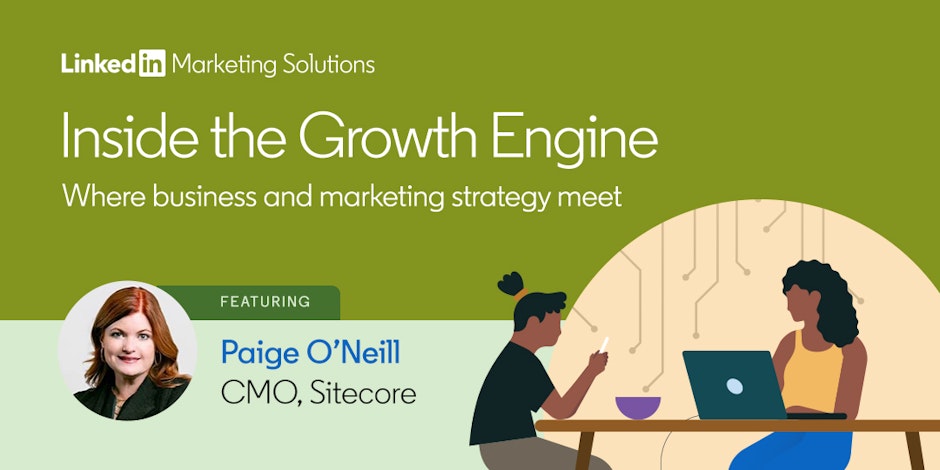Paige O’Neill on how digital transformation is enabling B2B brands to contribute to growth more than ever before
The chief marketing officer for Sitecore argues that B2B brand campaigns have an increasingly broader role in driving growth – but marketers still need to be savvy when it comes to making the case for them

Your rapidly growing software business has doubled in size in the last six months with accelerating demand for its digital experience platform and a raft of acquisitions. How can you deliver the wider awareness, sales pipeline and skilled talent that you need to continue scaling? How do you maintain both momentum and quality when growing so fast?
Sitecore’s chief marketing officer (CMO) Paige O’Neill knows the answer. This is her seventh CMO role in a two-decade-long career that’s seen her working at companies of every size from embryonic start-ups to publicly listed enterprises. She knows that different milestones in a company’s growth cycle require a different focus for marketing. And what a rapidly scaling business needs to ensure sustainable future growth is a strong brand.
“We’re a leader in our space and well-known among technologists and the companies that use us every day, but we need to dramatically expand the global audience that knows Sitecore and understands what we do,” says O’Neill. “One of the most interesting things about being a CMO is going into companies at different phases of growth and understanding what their particular business challenge is. A global brand campaign to introduce Sitecore to new audiences is one key area we need to focus on at this point.”
So far it sounds like a traditional brand building brief. However, O’Neill isn’t planning to elevate Sitecore and stake out a wider addressable market using traditional tools alone. She argues that the nature of brand building for B2B businesses has changed – and that tactics and strategy need to change in response.
A tech-enabled approach to brand building
“We’ve all seen the stats about how buying process has completely changed and up to 80% of the research phase takes place before buyers stick up a hand and tell you that they’re interested,” she says. “You’ve got to make sure that you’re top of mind for your target audiences. However, the notion of how you do that is changing as well. If you were doing a brand campaign, you used to think automatically of TV and airport billboards. The technology available today means that we’re able to be much more targeted. LinkedIn enables us to really filter down who we are trying to reach with our branding. That’s made branding a more relevant option for smaller B2B companies than it ever has been.”
O’Neill’s view on the value of targeting to B2B brand campaigns is based on long experience of how the conversation about brand marketing ROI plays out. “There’s a real difference between the theory of brand and then the practice of standing in front of the board and being asked to explain how you spent millions of dollars,” she says. “In theory there can be recognition that this is a longer-term investment and needs to be measured in a completely different way. In practice, once that campaign starts to run, you will still get questions about the contribution it’s making to pipeline. We’ve got to be aware of that and make sure that we can point to that contribution. The fact that a brand campaign can now be targeted, and you can point to movement within those targeted customers, gives you something to leverage.”
On the front lines of the customer experience revolution
Technology and data is doing more than making brand marketing a more accessible option in B2B. It’s also helping to broaden the role of marketing as a whole by positioning it at the forefront of digital transformation.
“During my 20+ years in marketing, the profession has gone from not really thinking about leveraging technology to a point where everything we do is automated and measured to the nth degree,” says O’Neill. “Over the same time, we’ve seen digital customer experience advance to become as important as physical experience. Marketing’s been on the front lines of this, putting content out there and getting feedback quicker than anyone else in the business. It’s a unique position that’s increased the scope of the CMO’s role because we were among the first to understand how important digital customer experience was becoming.”
Talent: the other crucial audience for B2B brands
It’s not just the customer experience that matters, though. O’Neill is keenly aware that the brand she’s designing for Sitecore doesn’t just need to support pipeline and widen demand. It has another audience that’s equally crucial for a business looking to scale quickly.
“The competition for talent in tech is fierce,” she says. “It’s changing the dynamics within business – and it’s an area where marketing has the opportunity to lead. Five or ten years ago, we’d be putting content and messaging out into the world and thinking just about how our buyers would respond. Now we’re thinking about the talent that we’re trying to attract to the company as well. That’s a big reason why sustainability and diversity are now so important to a brand. The younger generation that’s coming up and taking over the business world flat out don’t want to do business with companies that don’t follow diverse hiring practices or take social responsibility. They don’t want to work for them either.”
In a digitally transforming world, B2B brands have more to contribute to growth than ever. That’s why CMOs like Paige O’Neill are so determined to use all of the data and technology available to make the case for them.

